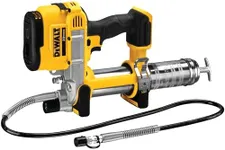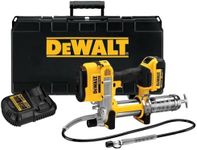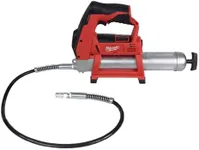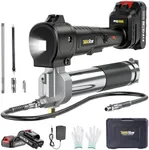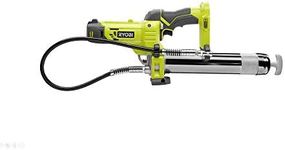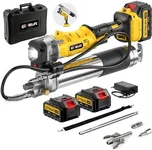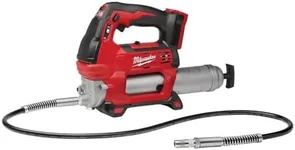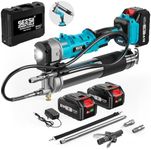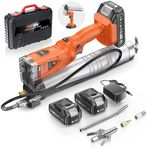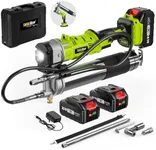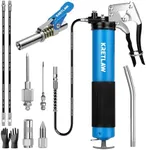Buying Guide for the Best Battery Powered Grease Gun
Choosing the right battery-powered grease gun can make your maintenance tasks much easier and more efficient. These tools are essential for lubricating machinery and equipment, ensuring they run smoothly and last longer. When selecting a battery-powered grease gun, it's important to consider several key specifications to ensure you get the best fit for your needs. Understanding these specs will help you make an informed decision and choose a grease gun that meets your specific requirements.Battery VoltageBattery voltage indicates the power of the grease gun. Higher voltage typically means more power and longer run time. Common voltages are 12V, 18V, and 20V. For light to moderate use, a 12V battery may suffice. For more demanding tasks or frequent use, consider an 18V or 20V battery. Your choice should depend on the intensity and frequency of your lubrication tasks.
Battery Capacity (Ah)Battery capacity, measured in ampere-hours (Ah), determines how long the battery will last on a single charge. Higher Ah means longer battery life. Typical capacities range from 2.0Ah to 5.0Ah. If you have long or multiple tasks, a higher capacity battery will be beneficial. For occasional or short tasks, a lower capacity battery may be sufficient.
Maximum PressureMaximum pressure, measured in PSI (pounds per square inch), indicates the force with which the grease is dispensed. Higher pressure is useful for heavy-duty applications and stubborn fittings. Common pressures range from 6,000 PSI to 10,000 PSI. For general maintenance, 6,000-7,000 PSI is usually adequate. For industrial or heavy machinery, consider a grease gun with higher pressure capabilities.
Flow RateFlow rate, measured in ounces per minute, indicates how quickly the grease is dispensed. Higher flow rates can speed up the lubrication process. Typical flow rates range from 3 oz/min to 10 oz/min. For quick and efficient lubrication, a higher flow rate is preferable. For more controlled and precise applications, a lower flow rate may be better.
Hose LengthHose length determines how easily you can reach different parts of the machinery. Longer hoses provide more flexibility and ease of use. Common lengths range from 24 inches to 48 inches. If you need to reach tight or hard-to-access areas, a longer hose is beneficial. For standard applications, a shorter hose may be sufficient.
WeightThe weight of the grease gun affects how comfortable it is to use, especially for extended periods. Lighter models are easier to handle and reduce user fatigue. Weights typically range from 6 to 10 pounds. If you will be using the grease gun for long durations or in various positions, a lighter model is preferable. For occasional use, weight may be less of a concern.
Build Quality and DurabilityBuild quality and durability determine how well the grease gun will withstand regular use and harsh conditions. Look for models with robust construction and high-quality materials. This is especially important for industrial or heavy-duty applications. For light to moderate use, standard build quality may be sufficient. For frequent or demanding tasks, invest in a more durable model.
Additional FeaturesAdditional features such as LED lights, variable speed triggers, and ergonomic grips can enhance the usability and convenience of the grease gun. These features can make the tool easier to use and more efficient. Consider which features are important to you based on your specific needs and preferences. For example, LED lights can be helpful in low-light conditions, while variable speed triggers allow for more control over the grease flow.
